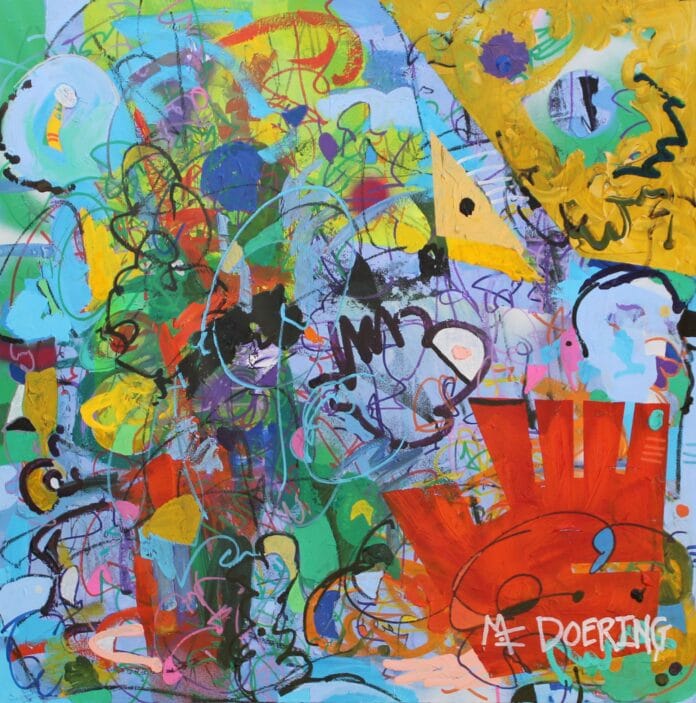Michael Doering (b. 1966) is an American painter and printmaker whose work bridges the deeply personal with the universally expressive. Born in Mason City, Iowa, and now based in Reno, Nevada, Doering’s journey to becoming a full-time artist was anything but straightforward. His story is one of persistence, reinvention, and a relentless drive to create. Today, his art resonates with viewers worldwide, weaving together autobiography, storytelling, and an instinctive search for meaning through expressive visual language.
Early Life and Influences
Growing up in a working-class Midwestern family, Doering had little exposure to fine art in his early years. Yet, an innate curiosity and resourcefulness drove him to make art from whatever was available, whether notebook paper or ballpoint pens. This self-taught ingenuity not only nurtured his love of drawing but also shaped his distinctive artistic practice.
Doering’s roots remain a crucial part of his work. Straddling the worlds of rural working-class life and contemporary art, he brings a dual perspective to his paintings. Themes of class, identity, and personal history often surface in his pieces, layered with humor, reflection, and sometimes haunting questions. Stylistically, he draws on Expressionism, Post-Impressionism, street art, and contemporary portraiture, forging a hybrid approach that balances tradition with experimentation.
Education and Artistic Formation
Doering’s formal artistic path began at the University of Iowa, where he earned a BFA in Studio Art in 1989. There, he studied painting and drawing under Ben Frank Moss and learned the intricacies of printmaking with Virginia Myers. This foundation in both painting and printmaking gave him the tools to explore contrasting techniques and build his own voice as an artist.
His academic journey did not stop there. Doering later pursued advanced degrees in education, earning a Master’s in Counseling and Educational Psychology in 1995, and a second Master’s in Educational Leadership in 1997, both from the University of Nevada, Las Vegas.
These experiences shaped his understanding of human behavior and storytelling perspectives that would later seep into his art. But his professional path first took him away from the canvas. For years, Doering worked as a teacher, counselor, principal, and district administrator, dedicating himself to education.
A Return to Painting
It wasn’t until 2017 that Doering returned to art full-time. After decades of balancing professional commitments, he made the bold decision to reclaim his identity as a painter. This return was transformative. His work quickly gained recognition, earning him an international following and leading to exhibitions not only across the United States but also in Dijon, France, and Santiago, Chile.
The years away from painting, rather than detracting from his artistry, had enriched it. His experiences in education and leadership brought new dimensions to his work, layered storytelling, empathy, and a willingness to embrace tension and contradiction.
Artistic Philosophy
At the heart of Doering’s creative practice lies tension: between past and present, control and chaos, storytelling and abstraction. His process thrives on risk. He admits to pushing a piece to the edge of ruin before pulling it back, finding beauty in the precarious space between destruction and resolution.
For Doering, art is about more than simply creating; it is about discovering, questioning, and revealing what lies beneath the surface. Each piece becomes a narrative in its own right, blending autobiography with imagined characters and open-ended metaphors.
He describes his work as instinctive and experimental, rooted in storytelling but free from rigid structures. His influences are broad, but the results are uniquely his own, bold, textured, and emotionally resonant.
Featured Work: Did You Ever Go There Alone?
One of Doering’s most compelling works, Did You Ever Go There Alone?, captures the spirit of his artistic voice. Created as a mixed media piece on canvas, it is inspired by a haunting refrain: a song without a source, one that lingered in the artist’s mind for five years.
The piece channels that mysterious melody “Did you ever go there alone?” through bold strokes and layered textures. It is less an attempt at explanation and more an acknowledgment of the inner voices that guide us. With its intuitive marks and abstract depth, the painting invites viewers to consider solitude, self-reflection, and the unanswered questions that echo in the human experience.
Doering’s description frames the work as both personal and universal: a meditation on following whispers, listening to the rhythms of inner songs, and embracing the quiet power of being alone. For anyone who has lived inside an unanswered question, the painting becomes a mirror of their own silent journeys.
Exhibitions and Recognition
Since resuming his practice full-time, Doering’s art has been shown in numerous exhibitions in the U.S. and abroad. His expressive, layered approach has drawn collectors, critics, and audiences who are captivated by the honesty and tension in his work. From Iowa roots to Nevada studios to international galleries, his career arc reflects both resilience and reinvention.
Conclusion
Michael Doering’s artistic journey is a testament to perseverance, instinct, and the transformative power of art. From a Midwestern childhood with limited artistic exposure to international recognition as a painter and printmaker, his path has been unconventional yet deeply meaningful.
His work bridges autobiography with contemporary expression, straddling the line between control and chaos, past and present, humor and haunting silence. Paintings like Did You Ever Go There Alone? He embodies his philosophy of pushing boundaries, embracing tension, and telling layered stories.
For Doering, art is not about perfection; it is about discovery. His paintings invite us to listen to the echoes within ourselves, to sit with unanswered questions, and to find meaning in the spaces between silence and song.


